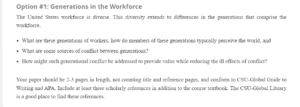Workforce Generations
What are these generations of workers, and how do members of these generations typically perceive the world?
The traditional generation
Most of the workers in this generation have retired, making it the oldest generation in the workplace. Also known as the greatest generation, the veterans and the Silents. The workers in this generation were born before 1945. These workers were subject to World War II and the great depression, among other events, which made them obligated and have fiscal restraint. They like formality and need respect and observe the top-down chain of command. They have been characterized as silent and private and believers in paying their dues (Tolbize, 2008). Their word is their bond, and they greatly respect authority and social order. The traditional generation has been featured as loyal workers committed to teamwork and collaboration. They are presumed to display command and control, leadership, consistency, and uniformity at work.
Are you interested in obtaining a new and unique copy of “Workforce Generations”? We’re here to help, so don’t hesitate to contact us.
The Baby Boom generation
Most sources identify this generation as people born between 1943 and 1965. Their name is attributed to the extra 17 million babies. This generation partook and witnessed the social turmoils of their time: the civil riots, the assassinations of King and Kennedy, the sexual revolution, and the Vietnam War. They were raised to respect authority but only trust a few people within their circle. Boomers are characterized as people who believe that to succeed, they must work and sacrifice. The trend of workaholics started with them. They, too, like teamwork, are competitive, loyal to employers, and like group decision-making (Tolbize, 2008). The workers in this generation are confident task completers who dislike constant feedback, although they want their success to be recognized.
Generation X
The Census Bureau defines this generation as the people born between 1968 and 1979. Because of its small size, it was also called the baby-bust generation. Their name was a result of a book Coupland wrote. Generation X members are the older boomers’ children and were raised in a period when societal, familial, and financial insecurities were present. AIDS, MTV, and the competition of video games influenced them. Compared to the previous generations, they aspire to balance work and life. They are also more independent, self-reliant, and autonomous. They have the most loyalty to their family and friends and are not overly loyal to their employers. They value continuous learning and development of skills as having strong technical skills and being result-oriented. Money does not motivate them, and they like receiving feedback.
Generation Y
This generation may include those born between 1980 and 2000. The period when they were born is not finalized yet. Other labels for this generation have Millenials, Digital generation, and Net generation; these individuals label themselves as the Wannabees, the Cyberkids, the Nothing-Is-Sacred age, and the Feel-Good generation. Computers characterize them, the dramatic advance in technology, and parental excesses. They share many characteristics with Generation X. They value collective action, teamwork, optimism, and adaptability to change (Tolbize, 2008). Additionally, the Millennials are multi-taskers, the most highly educated generation, the most confident age, and value training.
What are some sources of conflict between generations?
Work-value conflicts can occur because of work-life balance issues, differences in technology use, miscommunication, and other issues among the four generations in the workplace. The personnel problems include older worker/ younger supervisor problems and teamwork issues (Hillman, 2014).
The basis of Judging work
The younger generations are criticized by boomers as lacking work ethics. The older generations believe that a demonstration of ethics in the workplace is being in the office for long hours and being part of the organization (Birkman, 2016). Independence is a salient feature of the younger generations. They want their work to be measured on merits, not office hours.
The difference in communication styles and the technology divide
Social media is one of the main drivers of the technology divide. The younger generations have more channels of communication, fast communication, and access to more resources that allow them to judge what they believe. The older generations perceive the ability of the young age to access and interpret information as less thoughtful.
How might such generational conflict be addressed to provide value while reducing the ill effects of competition?
Communication and Respect
The conflicts in the generations may more likely arise from perception and attribution errors than valid differences. Therefore, effective communication should be employed in organizations to deal with disputes. Aggressive communications are proposed to create an inter-generational workforce.
Training and mentoring
Mentoring and training programs ensure the passing of skills. These programs can be bidirectional: the young workers can mentor the older workers on computer skills and technology, and the older generations can pass on their knowledge gained from years of experience.
Other Related Post: Facility Layout Sawhill Athletic Club
References
Hillman, D. R. (2014). Understanding multigenerational work-value conflict resolution. Journal of Workplace Behavioral Health, 29(3), 240-257.
BIRKMAN. (2016). How Generational Differences Impact Organizations & Teams. Retrieved from https://birkman.com/wp-content/uploads/2016/05/Generational-Differences-PDF.pdf
Tolbize, A. (2008). Generational differences in the workplace. Research and training center on community living, 5(2), 1-21.
ORDER A PLAGIARISM-FREE PAPER HERE
We’ll write everything from scratch
Question
Option #1: Generations in the Workforce
The United States workforce is diverse. This diversity extends to differences in the generations that comprise the crew.

Workforce Generations
- What are these generations of workers, how do members of these generations typically perceive the world, and
- What are some sources of conflict between generations?
- How might such generational conflict be addressed to provide value while reducing the ill effects of competition?
Your paper should be 2-3 pages long, not counting the title and reference pages, and conform to CSU-Global Guide to Writing and APA. Include at least three scholarly references in addition to the course textbook. The CSU-Global Library is an excellent place to find these references.

